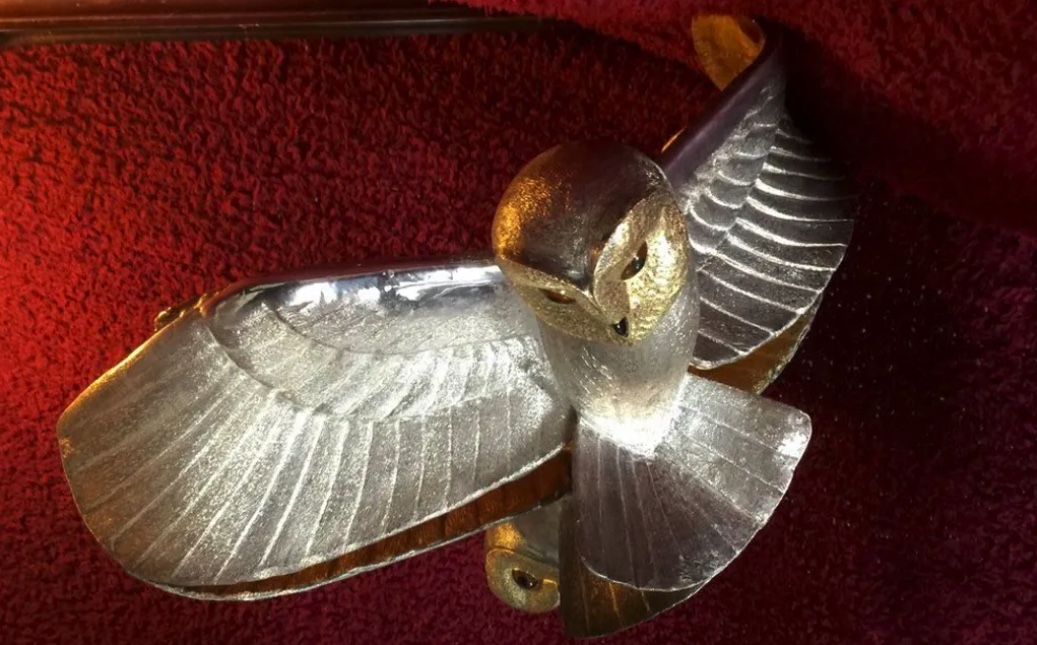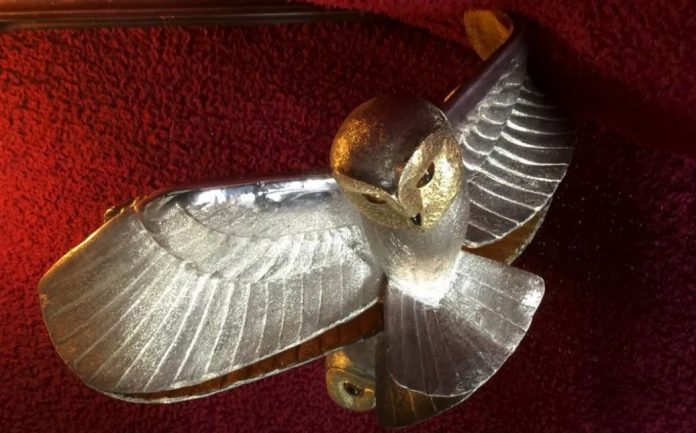การล่าสมบัติที่ยาวนานที่สุดในโลกดูเหมือนจะสิ้นสุดลง หลังจากมีการประกาศในฝรั่งเศสว่านกฮูกทองคำที่ถูกฝังได้ถูกค้นพบแล้วในที่สุด หลังจากผ่านไป 31 ปี
“เราขอยืนยันว่าแบบจำลองของนกฮูกทองคำได้ถูกขุดพบเมื่อคืนที่ผ่านมา และพร้อมกันนั้นก็ได้มีการส่งคำตอบเข้าสู่ระบบการยืนยันออนไลน์แล้ว” ข้อความที่โพสต์เมื่อเช้าวันพฤหัสบดีในช่องสนทนาทางการของการล่าสมบัติระบุ
“ดังนั้นจึงไม่มีความจำเป็นที่จะต้องเดินทางไปขุดในที่ที่คุณคิดว่าอาจเป็นที่ซ่อนสมบัติอีกต่อไป”
ข้อความนี้โพสต์โดย Michel Becker ผู้วาดภาพประกอบหนังสือ Chouette d’Or (นกฮูกทองคำ) และเป็นผู้แกะสลักรูปปั้นที่ถูกฝังในปี 1993 ไม่มีข้อมูลเพิ่มเติมเกี่ยวกับสถานที่หรือผู้ค้นพบ และไม่สามารถติดต่อคุณ Becker ได้ทางโทรศัพท์
ผู้คนนับหมื่นคนเข้าร่วมในการค้นหาสมบัตินี้ ซึ่งได้ก่อให้เกิดวรรณกรรมลำดับสองจำนวนมาก ทั้งในรูปแบบหนังสือ โบรชัวร์ และเว็บไซต์ พวกเขาต่างติดตามปริศนาทั้ง 11 ข้อที่ซับซ้อนในหนังสือเล่มแรกที่สร้างโดย Max Valentin เมื่อเขาเสียชีวิตในปี 2009 คุณ Becker ก็เข้ามารับหน้าที่ดำเนินการต่อ
เบาะแสที่ซับซ้อนเหล่านี้ควรจะนำไปสู่จุดที่ชัดเจนที่ไหนสักแห่งในฝรั่งเศส ซึ่งจะพบแบบจำลองนกฮูกทองคำที่ทำจากบรอนซ์ถูกฝังอยู่ ผู้ชนะจะได้รับนกฮูกทองคำจริงที่มีค่า
สารคดีเกี่ยวกับการล่าสมบัติที่ออกอากาศโดยผู้แพร่ภาพของฝรั่งเศส Canal+ เมื่อต้นปีนี้กล่าวว่า นกฮูกทองคำนี้มีมูลค่าประมาณ 150,000 ยูโร (ประมาณ 126,000 ปอนด์)
เช้าวันพฤหัสบดีที่ผ่านมา โลกของนักล่าสมบัติที่เรียกว่า “chouetteurs” ตื่นตระหนกเมื่อข่าวการค้นพบนี้แพร่สะพัด “ในที่สุดก็ได้เป็นอิสระแล้ว!” โพสต์หนึ่งในช่องสนทนา Discord ระบุ
“ไม่คิดเลยว่าจะมีชีวิตถึงวันที่ได้เห็นเหตุการณ์นี้” โพสต์อีกข้อความกล่าว และอีกข้อความหนึ่งว่า “เหมือนโควิดเลย ดีใจที่มันจบลงแล้ว”
“รู้สึกแปลกใจที่โล่งใจจัง อยากรู้จริง ๆ ว่าคำตอบเป็นยังไง จะได้รู้ว่าตัวเองมาถูกทางหรือเปล่า” ผู้ใช้รายหนึ่งแสดงความคิดเห็น
อย่างไรก็ตาม นักล่าสมบัติบางคนยังคงสงสัย เกรงว่าการค้นพบสมบัติครั้งนี้อาจมาจากการใช้เครื่องตรวจจับโลหะตามที่มีกฎระบุว่า ผู้ค้นพบต้องแสดงให้เห็นว่าพวกเขาแก้ปริศนาได้ถูกต้อง ไม่ใช่แค่บังเอิญพบโดยไม่ตั้งใจ
การล่าสมบัตินี้เคยตกอยู่ในความขัดแย้งทางกฎหมายหลายปีหลังการเสียชีวิตของคุณ Valentin และนักล่าสมบัติบางคนไม่ยอมรับที่คุณ Becker เข้ามารับช่วงหน้าที่สำคัญนี้ คุณ Becker เองก็ไม่ได้รู้ถึงสถานที่ที่นกฮูกถูกฝังตั้งแต่แรก คำตอบนั้นถูกเก็บไว้ในซองที่ปิดผนึกซึ่งอยู่ในความครอบครองของครอบครัวของคุณ Valentin
แต่หลังจากปัญหาทางกฎหมายได้รับการแก้ไข คุณ Becker ได้อ่านคำตอบและเดินทางไปยังสถานที่นั้นเพื่อยืนยันว่านกฮูกยังคงอยู่ที่เดิม ในช่วงหลายปีที่ผ่านมา เขาได้ปล่อยเบาะแสเพิ่มเติมให้กับชุมชนนักล่าสมบัติ ทำให้เกิดความสนใจจากนักล่าสมบัติรุ่นใหม่
Treasure hunter finally finds Golden Owl after decades

The world’s longest treasure hunt appears to have come to an end, after an announcement in France that a buried statuette of a golden owl has finally been unearthed – after 31 years.
“We confirm that the replica of the golden owl was dug up last night, and that simultaneously a solution has been sent on the online verification system,” reads a post published on Thursday morning on the hunt’s official chatline.
“It is therefore now pointless travelling to dig at any place you believe the cache might be situated.”
The message was posted by Michel Becker, who illustrated the original Chouette d’Or (golden owl) book and sculpted the buried statuette in 1993.
No further information about the site or the finder was available and Mr Becker was not contactable by telephone.
Tens of thousands of people have taken part in the search, which has spawned a huge secondary literature in books, pamphlets and Internet sites.
They have all been following 11 complicated puzzles set out in the first book by its creator, Max Valentin. When he died in 2009, Mr Becker took over the operation.
The complex clues were supposed to lead to a precise point somewhere in France, where a bronze replica of the actual golden owl would be found under the ground. The winner would get the precious gold original.
A documentary on the treasure hunt by French broadcaster Canal+ said earlier this year that the value of the owl is estimated to be €150,000 (£126,000).
The world of chouetteurs – as the treasure-hunters are called – was in uproar on Thursday morning as news of the reported find spread.
“Finally – liberated!” reads one post on the hunt’s chatline on the Discord forum.
“I didn’t think I’d live to see the day,” reads another. And: “It’s like Covid. So good when it’s over.”
“Curiously, I’m relieved. I’m desperate to know the solutions now to see if I was on the right path,” comments another user.
Some hunters remained sceptical, fearing that the cache might have been discovered with a metal detector. Under the rules, the finder has to show that they correctly solved the enigmas and did not just stumble upon the owl by chance.
The hunt was mired in legal rows for some years after Mr Valentin’s death, and not all owl-hunters accepted Mr Becker’s inheritance of the central role.
Mr Becker himself originally had no knowledge of the situation of the buried owl. The solution was in a sealed envelope in the possession of Mr Valentin’s family.
But after the legal difficulties were resolved, Mr Becker read the solution and travelled to the spot to verify that the owl was still there.
In recent years, he has released more clues to the owl community, triggering interest in a new generation of chouetteurs.
By Hugh Schofield, BBC News

















